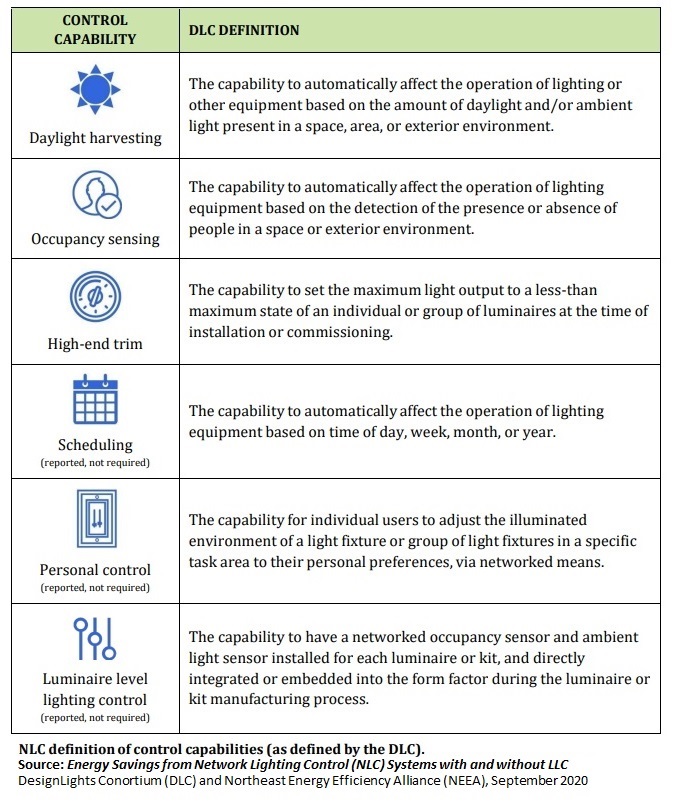 By now, it’s no secret that networked lighting controls (NLC) can deliver significant value for facility owners and managers looking to maximize energy savings while moving toward greater building intelligence.
By now, it’s no secret that networked lighting controls (NLC) can deliver significant value for facility owners and managers looking to maximize energy savings while moving toward greater building intelligence.
Capitalizing on the ubiquitous nature of ceiling lights, connected “smart” LEDs can collect data on space utilization, occupancy and other many other factors, enabling building systems to respond to the real-time needs of both facility managers and occupants.
In terms of energy savings, a September 2020 study by the DesignLights Consortium (DLC) and Northwest Energy Efficiency Alliance (NEEA) found that NLCs can boost the energy efficiency of stand-alone LED commercial lighting projects by nearly 70 percent for some building types—with savings across various categories of buildings averaging 49 percent—compared with savings possible through LEDs alone. With the US Department of Energy projecting that connected lighting will comprise almost a third of all lighting in commercial buildings by 2035, the market for NLCs appears poised to hit its stride.
The devil is in the details, however, and a few factors continue to thwart NLCs from reaching their full potential. While studies have consistently supported the largely untapped promise of the technology, the DLC’s research has found that proper installation and configuration is essential to reap the full benefits of NLCs. Without this, their impact may be minimal.
As the DLC seeks to promote wider adoption of what we consider a game-changing technology, it’s apparent that lack of familiarity with how to choose, install, and properly configure NLC systems is a key barrier to widespread adoption. To clear this hurdle, we have developed training programs for the design and installation of NLCs, delivered through local electric utilities and their energy efficiency program administrators and available to an array of stakeholders, including building managers and contractors. These trainings are in two formats: self-guided/online and live/virtual hands-on.
In the online version of the course, students learn at their own pace, using a course dashboard to track their progress. Comprising eight modules, the course takes four to six hours to complete and features a simple-to-use design and concise narration covering topics such as:
- How to identify system configurations to maximize benefits in various situations;
- Questions to ask to understand a customer’s needs;
- System requirements, cybersecurity, and emergency lighting considerations;
- How to use the DLC’s NLC Qualified Products List to select systems that match client needs;
- Examples of what has and has not worked, and information on how manufacturers are making products more user-friendly and easier to install; and
- A design workshop to test student learning.
The DLC’s previously in-person, hands-on Advanced Lighting Control Systems Training Program has been adapted to a live/virtual format during the COVID-19 pandemic. It is still taught by Steve Mesh, a 39-year veteran of the US and international lighting design industry. Available through DLC Energy Efficiency Program members, the formerly hands-on/now virtual course guides students through topics such as system characteristics and wiring requirements, criteria for selecting appropriate control systems for any customer project, trends in the NLC market, and cutting-edge technologies and methodologies. It culminates with opportunities for live, hands-on experience setting up and commissioning a wireless networked lighting system virtually.
Students leave this course with the expertise and confidence needed to explain system features and benefits based on customers’ specific needs. Said one alumnus, “It will help me to better answer my customers’ questions when I try to influence them to take their lighting projects to the next level.”
Taking the guesswork out of NLC installation and configuration is an effective tactic for pointing the LED market in a more controls-friendly direction that creates a foundation for smart buildings and facilitates substantial savings in energy use. From an energy perspective alone, there is no time to waste. Since LEDs installed now may run for a decade or more, ignoring controls at the time of installation could strand potential energy and cost savings for years to come.
Moreover, as research improves our understanding of how light affects human health, wellness, and productivity, we know the time is also ripe for supporting the installation of products whose virtues go beyond saving energy. Removing perceived roadblocks to connected lighting is a strategic step toward assuring that illumination of offices, hospitals, schools and other commercial spaces support human comfort, productivity and well-being.
###
Liesel Whitney-Schulte, LC, is the Program Director for the DLC, where her responsibilities include program design, development and management to help advance quality lighting products in the market. Liesel is driven by a passion for effective lighting and has over 20 years of experience in energy efficiency program administration and implementation.
For more information about the DLC’s online and virtual NLC training courses, please email training@designlights.org

